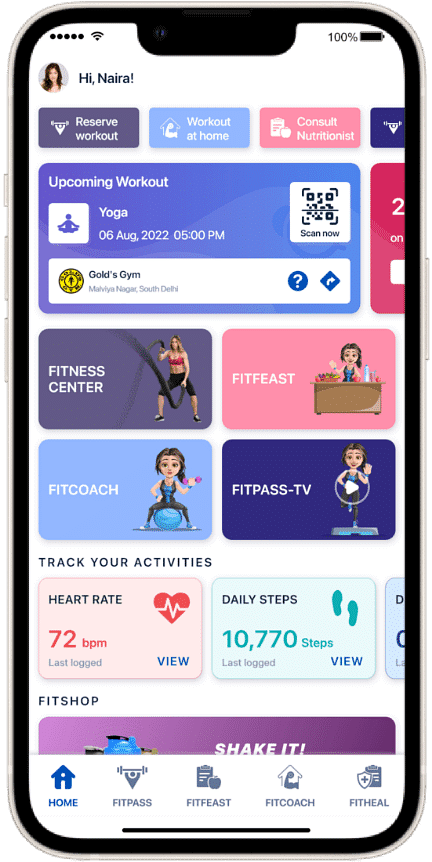Brisk Walking: How To Do, Benefits & More
Table of Contents
Brisk walking, a form of physical activity that involves walking at a faster pace than usual, is not only a simple and effective way to boost your fitness and overall health but also a convenient one. It can be done anywhere, anytime, without the need for any special equipment. Walking and brisk walking are also considered forms of cardio exercise.
This blog will discuss brisk walking, its methods, and its many health benefits.
What is Brisk Walking?

Brisk walking is a type of physical activity that involves walking at a faster pace than usual. It is sometimes called power walking or speed walking. Brisk walking is not jogging or running but is more rapid than regular walking.
When you briskly walk, your heart rate increases, and you may start to breathe slightly more complicated than usual. Although brisk walking may not be as intense as running, it still works up many muscles and helps improve your overall health and fitness.
How to Do Brisk Walking?

Brisk walking is a straightforward activity that anyone can enjoy anywhere. All you need to embark on this journey is comfortable shoes and some space to walk. Here are some simple tips to get you started:
- Warm-up: Start with a slow and steady walk for 5-10 minutes to warm up your muscles.
- Increase Pace: Gradually increase your pace and try to walk at a speed that makes you breathe harder but still allows you to carry on a conversation.
- Maintain Posture: Keep your head up, shoulders back, and arms swinging naturally.
- Duration: Aim for at least 30 minutes of brisk walking per day.
- Cool down: End your brisk walking session with a slow walk for 5-10 minutes to cool down your muscles.
How to Measure Brisk Walking?

There is no standardised way to measure brisk walking. Your walking pace is the key to following if you want to know at what rate you are brisk walking. Numerous fitness gadgets can calculate your brisk pace.
Target Heart Rate
You are keeping track of your heart rate during exercise or brisk walking, which can also work. To calculate your maximum heart rate, subtract your age from 220. For instance, if you're 30, your maximum heart rate would be 190. Ideally, any moderate–intensity activity like brisk walking should be about 50% to 70% share of your maximum heart rate. Another manual technique to check your heart rate is pressing your index finger against the artery on your wrist for 30 seconds. Multiply the results by two, and you will get your answer.
Count Your Steps
Your regular walk' step counts may remain around 40-60 steps per minute, depending on your pace. If you plan to walk briskly, your steps must ideally remain 100 counts per minute. That means if you're walking for 30 minutes straight, you must walk 3000 steps. You can keep a count in your head or use various fitness gadgets to track your step counts. The average recommendation to briskly gain profound benefits from walking is 150 minutes. Achieving this target is only possible with gradual progress. Take intervals in your walks after a few minutes and start another rep.
Talk Less Walk More
While performing any moderate-intensity exercise, people tend to focus on their actions rather than words. It is because you use less energy and store your breath. During brisk walking, you can easily measure whether your pace is maintained; you can try by talking faster or even singing. If you can perform these actions efficiently, you must intend to walk fast while matching the pace of an actual brisk walking workout.
Benefits of Brisk Walking

Like any exercise, brisk walking also has plenty of excellent benefits.
Burn Calories
Brisk walking is a cardio exercise that can burn up to 300 calories per hour, making it an effective way to manage weight. There's a misconception that mere walking cannot help you burn fat. But that is not true. Brisk walking has enough intensity to burn fats and help you lose weight.
Boosts Cardiovascular Health
Brisk walking is a great way to improve your heart health, reduce your risk of heart disease, and lower your blood pressure. It also boosts the efficiency of your cardiovascular system. It releases endorphins that boost your energy levels and elevate your body's oxygen levels.
Strengthens Muscles
Brisk walking works the muscles of your legs and abdomen, toning them and improving their strength. Walking is an excellent way to build muscle strength and endurance. It also helps prevent the degeneration of bones and joints.
Relieves Stress
Like any other exercise, Brisk walking releases natural mood-boosting hormones called endorphins that can help reduce stress and anxiety. Even a short brisk-walking session can alleviate your mood and make you feel positive.
Low-Impact Exercise
Unlike running, brisk walking is a low-impact exercise that is easy on the joints. That makes it an excellent exercise for older individuals with weaker joints. Even if individuals are unwilling to perform intense workouts, they can incorporate brisk walking into their schedules and enjoy the super effects of their fitness routine.
How many Calories are Burned During Brisk Walking?

Several factors affect your calorie burn rate, including your body weight, age, sex, workout duration, and intensity. Your pace also affects how many calories you might burn, and how long you work out will define your burning rate. For example, if a 140-pound person walks 3 miles per hour for 30 minutes, they burn roughly 112 calories.
Where Can You Do Brisk Walking?

The most significant advantage of brisk walking is that it can be done anywhere—at home, in the open, at the fitness centre, you name it. All you need is some space. You can pace around your house for 30 minutes or go for a short walk nearby. Brisk walking when getting your groceries is another great way to exercise while finishing your chores.
Brisk Walking at the Gym
It's okay to walk outside the gym. You can also practice walking on the treadmill at gyms or fitness studios near you. Set the treadmill slowly (about 3.5 MPH) and start your brisk walk. You can adjust the speed to match your stride.
Walking on the treadmill is a great way to warm your body before a full-blooded run. It's also an excellent idea if you need more time to feel ready for an intense run or workout.
It's better to incorporate brisk walking into your workout routine or go out in the park and start with your brisk walking session. Keep a count of your daily steps with the FITPASS app, which has an in-built feature for tracking step counts, measuring heart rate, calories burned, etc., along with other fitness solutions for your daily health and lifestyle. Download the FITPASS app and accomplish your fitness goals right now.
A Few Tips and Techniques for Brisk Walking

If you're new to any walking exercise, then brisk walking for a longer duration is optional. Here are a few expert tips you can remember during your brisk walking workouts.
Arm Swings
Arm swings are the perfect way to double the effect of brisk walking. Keep your arms in motion while you walk, which can have a full-body workout effect and create balance.
Maintain Proper Form
Try not to hunch or twist your body; keep your shoulders free. You must avoid looking down while walking so that your body can maintain proper posture.
Challenge Yourself
If you feel proficient in brisk walking and want to elevate your level, you can use ankle weights while keeping your stride short and effective. You can also carry weights or walk on an inclined road.
Take Intervals
Continuous brisk walking can be engaging but tiring, too. Plan to take intervals where you walk fast for a few minutes, then stroll and increase it the next moment.
Perform Calisthenics
Incorporate a few squats or lunges after every 15-minute interval. That can maximise the effect of your workout and tone your legs and abdominal muscles.
Conclusion
Brisk walking effectively benefits individuals from all stages and walks of life. It is an easy exercise that anyone can perform anytime and anywhere. You do not need any equipment or special arrangements for a brisk walk outside, and it can be done without some dedicated time for the workout.
If you're a working professional or a college student, walk your way to this beneficial workout. Just remain safe and clear from any mishap while walking on the road. Even if you're fit, brisk walking benefits you. Try to incorporate it into your daily routine and see the difference. Even if you do not have a particular workout routine, walking can help you reach your fitness goals quickly.
How does walking benefit health?
Walking improves overall health and fitness, increases muscle strength, aids weight loss, relaxes the mind, improves heart health and has plenty of other benefits.
Is walking better than running?
Both walking and running have their own benefits. Walking is a low-impact exercise that’s easier on the joints than running. But running, on the other hand, is more intense and burns more calories.
Brisk walking is what type of exercise?
Brisk walking is a moderate-intensity aerobic exercise. It elevates heart rate, improves cardiovascular health, and helps in weight management. It's a low-impact activity suitable for most fitness levels.
How to do brisk walking?
To do brisk walking, maintain a pace where you can talk but not sing. Keep your back straight, swing your arms, and take long strides. Aim for at least 30 minutes a day, five times a week for optimal health benefits.
What brisk walking?
Brisk walking is walking at a fast pace, typically around 3-4 miles per hour. It's a form of moderate-intensity aerobic exercise that helps improve cardiovascular health, burn calories, and enhance overall fitness.
What does brisk walking mean?
Brisk walking means walking at a faster pace, around 3-4 miles per hour. It's an effective aerobic exercise that elevates your heart rate, improves cardiovascular health, burns calories, and enhances overall fitness.
What is a brisk walk?
A brisk walk is a form of moderate-intensity exercise where you walk at a fast pace, typically 3-4 miles per hour. It helps improve cardiovascular health, burn calories, and enhance overall fitness levels.
What is brisk walk?
A brisk walk is a type of moderate-intensity aerobic exercise, involving walking at a fast pace, usually around 3-4 miles per hour. It's beneficial for cardiovascular health, weight management, and overall fitness.
What is brisk walking?
Brisk walking is a moderate-intensity aerobic exercise, involving walking at a fast pace, typically 3-4 miles per hour. It helps improve cardiovascular health, burn calories, and enhance overall fitness.
What is brisk walking?
Brisk walking is walking at a fast pace, usually around 3-4 miles per hour. It's a moderate-intensity aerobic exercise that improves cardiovascular health, helps with weight management, and boosts overall fitness.
Whats brisk walking?
Brisk walking is a form of moderate-intensity aerobic exercise, involving walking at a fast pace, typically 3-4 miles per hour. It helps improve cardiovascular health, burn calories, and enhance overall fitness levels.


